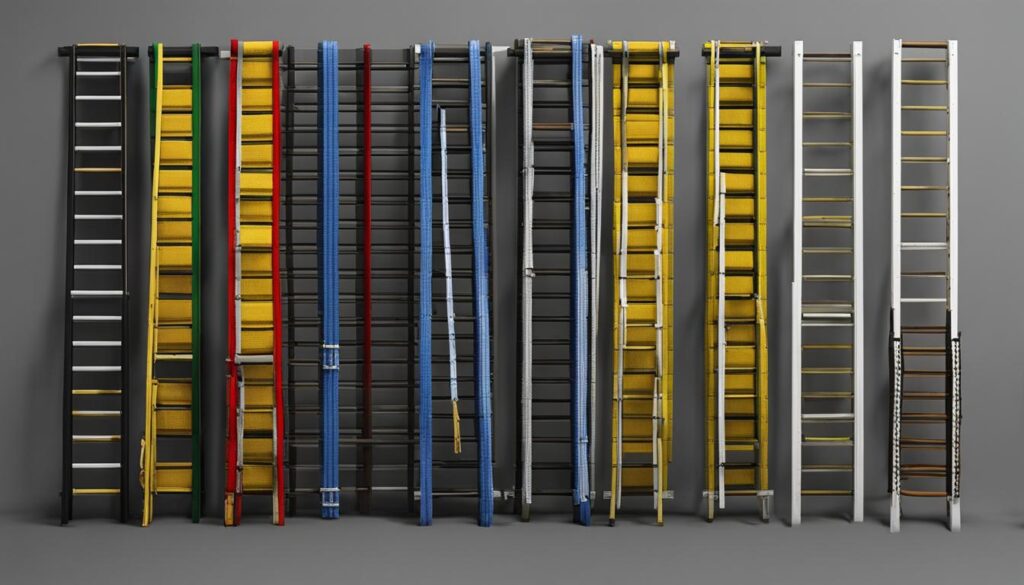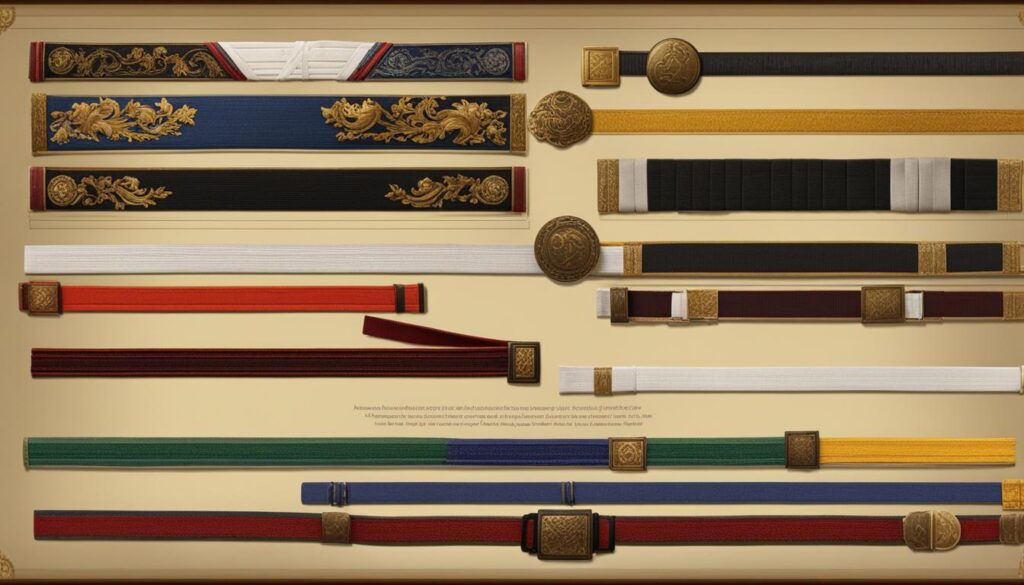Welcome to our comprehensive guide on karate belt progression and the ranking system. Whether you’re new to karate or a seasoned practitioner, understanding the order of belt ranks and their significance is essential for tracking your progress and setting goals on your martial arts journey.
Key Takeaways:
- The karate belt system is a modern addition to the martial art of Karate, using the kyu/dan grading system.
- The belt colors and ranks vary depending on the style, school, and country.
- The progression of karate belts starts with the white belt and goes through yellow, orange, green, blue, brown, and finally black belt.
- Kyu rankings denote a student’s progress in technique, with the brown belt being the highest level.
- The belt order follows a specific sequence of colors, symbolizing growth and mastery.
The Kyu Rankings in Karate
The kyu rankings in karate are used to denote a student’s progress in the technique. It starts with the white belt, which represents the beginner level, and moves sequentially down the kyu grades as the student develops. The most advanced student level is the 1st Kyu, also known as the brown belt. Different karate styles may have different numbers of kyu levels, such as 8, 9, 10, or even 12.
Understanding the kyu rankings is essential for karate students to track their progress and set goals for improvement. Each kyu level represents specific skills and knowledge that students must acquire before moving on to the next level. Advancement to a higher kyu rank typically requires passing a belt examination or demonstrating proficiency in various techniques and forms.
“The kyu rankings serve as a roadmap for karate students, guiding them on their journey towards mastery.”
It is important to note that the number of kyu levels can vary depending on the karate style or organization. While some styles may have a straightforward progression from white to brown belt, others may incorporate additional intermediate levels to provide more granular measurement of a student’s skill development.
To illustrate the kyu rankings in karate and their corresponding belt colors, refer to the table below:
| Kyu Level | Belt Color |
|---|---|
| White Belt | White |
| 9th Kyu | Yellow Belt |
| 8th Kyu | Orange Belt |
| 7th Kyu | Green Belt |
| 6th Kyu | Blue Belt |
| 5th Kyu | Brown Belt |
| 4th – 1st Kyu | Brown Belt |
The Karate Belt Order
In karate, the order of belts follows a specific sequence of colors. It serves as a visual representation of a student’s progress and skill level. Understanding the karate belt order is essential for any practitioner on their journey towards mastery. Let’s take a closer look at the karate belt ranking order and the significance of each level.
The Kyu Rankings
The karate belt order starts with the white belt, representing the beginning stage of a student’s journey. As they gain proficiency and knowledge, they progress through the ranks, including the yellow, orange, green, blue, and brown belts. The brown belt is the highest level in the kyu rankings, just one step away from achieving the coveted black belt.
The Dan Ranks
Upon reaching the brown belt, a karate practitioner enters the realm of the dan ranks. The black belt is the first level of mastery in the dan ranks. It signifies the transition from student to advanced practitioner. The dan ranks continue to progress from the 1st Dan, also known as Shodan, all the way up to the prestigious 10th Dan, the highest level of mastery in karate.
The karate belt order can be visually represented as follows:
| Belt Color | Rank |
|---|---|
| White Belt | Beginner |
| Yellow Belt | Beginner |
| Orange Belt | Beginner |
| Green Belt | Intermediate |
| Blue Belt | Intermediate |
| Brown Belt | Advanced (Highest Kyu Rank) |
| Black Belt | Advanced (First Dan) |
| Higher Dan Ranks | Advanced (2nd Dan and above) |

The karate belt order provides a clear path for students to follow as they progress through their training. Each belt represents a milestone in their development, marking a progression in both skill and knowledge. By understanding and respecting the karate belt order, practitioners can navigate their journey with confidence and purpose.
The Meaning of Each Karate Belt Color
Each karate belt color holds its own symbolic meaning, representing the progression and growth of a student’s journey in karate.
The white belt symbolizes the beginning and purity of the student’s karate journey. It represents a blank canvas, signifying the open-mindedness and potential for growth.
The yellow belt represents the first rays of sunlight and symbolizes the student’s willingness to learn and embrace new knowledge. It signifies the awakening of curiosity and the eagerness to explore the art of karate.
The orange belt embodies the spreading light that widens horizons and expands the student’s knowledge, both inside and outside the dojo. It is a stage of progress, where the student starts to understand the depth of karate principles and techniques.
The green belt signifies growth and the development of new skills. It represents a stage where the student’s techniques start to take root and flourish. It is a time of honing and refining movements, fostering confidence and competency.
The blue belt is associated with the sky, symbolizing the student reaching for new heights in their karate journey. It represents the continuous pursuit of knowledge and the exploration of advanced techniques. The blue belt stage emphasizes the importance of a strong foundation as a stepping stone to further learning.
The brown belt symbolizes maturity and readiness for the next level of mastery. It signifies the student’s growth in skill, knowledge, and character. The brown belt stage encourages the development of leadership qualities and the responsibility to guide and mentor less experienced students.
Table: Symbolic Meaning of Karate Belt Colors
| Belt Color | Symbolic Meaning |
|---|---|
| White Belt | Beginning and purity of the karate journey |
| Yellow Belt | First rays of sunlight, open-mindedness, and eagerness to learn |
| Orange Belt | Spreading light, broadening horizons, and expanding knowledge |
| Green Belt | Growth, development of new skills, and competency |
| Blue Belt | Reaching for the sky, pursuit of advanced knowledge and techniques |
| Brown Belt | Maturity, readiness for the next level of mastery, and leadership |
Understanding the symbolic meanings behind each karate belt color can deepen your appreciation for the journey of self-improvement and personal growth that karate represents. Each belt color represents a unique stage in a student’s development, fostering character, discipline, and resilience.
The Dan Ranks in Karate
The dan ranks in karate represent the advanced levels of mastery and expertise. These ranks denote the highest levels of achievement and symbolize the culmination of years of training and dedication. From the 1st Dan to the 10th Dan, each rank signifies a significant milestone in a karate practitioner’s journey. Here is a breakdown of the dan ranks and their corresponding black belt levels:
| Dan Rank | Black Belt Level |
|---|---|
| 1st Dan | Shodan |
| 2nd Dan | Nidan |
| 3rd Dan | Sandan |
| 4th Dan | Yondan |
| 5th Dan | Godan |
| 6th Dan | Rokudan |
| 7th Dan | Nanadan |
| 8th Dan | Hachidan |
| 9th Dan | Kyudan |
| 10th Dan | Judan |
It’s important to note that ranks beyond the 5th Dan are often honorary and not solely based on skill or technique. Higher dan ranks are usually granted based on merit, contributions to the art, or the instructor’s discretion. These ranks represent exceptional mastery and are typically held by highly respected karate practitioners.
As a karate practitioner advances through the dan ranks, their knowledge, skills, and understanding of the art deepen significantly. Achieving higher dan ranks requires continuous training, self-improvement, and a lifelong commitment to karate. It is a testament to the practitioner’s perseverance, discipline, and dedication to the art of karate.

Continue reading to learn more about the belt system, progression, and the journey of mastering karate.
The Karate Belt Order in Europe
The karate belt system in Europe has evolved over time, bringing together various styles and practices. Initially, the belt colors used in Europe were limited to white, brown, and black, following the traditional Japanese system.
However, in 1935, Mikinosuke Kawaishi introduced the colored belt system to Europe, which was inspired by Judo. This innovative approach brought a new dimension to the European karate community, allowing for a more visible representation of progress and skill level.
The colored belt system quickly gained popularity and became the standard in the grading system for European karate. By introducing a wider range of colors, it allowed practitioners to easily identify different levels of proficiency and celebrate their achievements.
Today, the karate belt colors in Europe can vary from school to school and organization to organization. While some schools adhere to a specific color sequence, others adopt their own unique belt order. This diversity adds a touch of individuality to each karate dojo, making the European karate community rich and vibrant.
It is important to note that there is no unified global standard for karate belt colors. Therefore, if you are a karate enthusiast traveling across different European countries, it is advisable to familiarize yourself with the specific belt order of the local dojo or organization.
In conclusion, the introduction of the colored belt system in Europe revolutionized the way karate practitioners track their progress and showcase their skills. This dynamic system ensures that each individual’s journey in karate is unique, embracing the diversity and rich heritage of European karate.
The Origins of Belts in Martial Arts
The belt system in martial arts, including karate, has a relatively modern origin, dating back to the turn of the 20th century. Before the introduction of belts, martial artists used certificates or diplomas to signify their level of knowledge and skill.
It was Jigoro Kano, the founder of Judo, who is credited with introducing the colored belt system in martial arts. Kano believed that the use of belts would allow students to advance more rapidly, providing them with a clear progression of skill levels. Additionally, the colored belts enabled fighters to quickly identify their opponents’ level of expertise, enhancing competition and training.
This innovation in martial arts grading quickly gained popularity and spread to various disciplines, including karate. Today, the belt system is a fundamental part of karate training, serving as a visual representation of a practitioner’s skill and experience.

The Belt System in Karate
The belt system in karate is an integral component of measuring progress and skill level. It consists of two sets of belts: the kyu set and the dan set.
The kyu set encompasses the colored belts and signifies the student levels in karate. It serves as a visual representation of a practitioner’s growth and development. Starting with the white belt, students progress through various colors such as yellow, orange, green, blue, and brown. The brown belt, equivalent to the 1st Kyu, marks the highest level in the kyu set.
The dan set, on the other hand, comprises the black belts and denotes the advanced levels of mastery in karate. Achieving a black belt requires a deeper understanding of the art, as well as a demonstration of technical proficiency and a strong character. The highest dan rank in karate is the 10th Dan, associated with the esteemed title of grandmaster.

Comparison of Belt Systems:
| Kyu System | Dan System |
|---|---|
| White, Yellow, Orange, Green, Blue, Brown | Black |
| Highest Level: Brown Belt (1st Kyu) | Highest Level: 10th Dan (Grandmaster) |
How to Achieve a Higher Rank in Karate?
Advancing to a higher rank in karate requires dedication, training, and passing a promotion or examination. Each rank has specific requirements and skills that need to be demonstrated. The lower kyu ranks focus on mastering the basics of karate, while the higher kyu ranks require more advanced techniques and applications. The time necessary for promotion varies depending on the school and the rank in question. Higher ranks may require a longer period of training before attempting promotion.
As you progress through the karate belt system, you will need to demonstrate your proficiency in various aspects of the martial art. This may include a combination of techniques, forms (kata), sparring, and knowledge of karate principles. Each examination or promotion will have a specific set of criteria that you must meet to advance to the next rank.
To prepare for a karate belt promotion, it is important to focus on consistent training and improvement. Regular attendance at classes and practice sessions will help you refine your technique and build strength and flexibility. Working with a qualified instructor or sensei can help you identify areas for improvement and provide guidance on how to achieve your goals.
Additionally, it is essential to maintain a positive mindset and stay committed to your karate journey. Progressing through the ranks takes time and effort, and there may be challenges along the way. Remember to set realistic goals and celebrate each milestone you achieve. Embrace the process of learning and growth, and don’t be discouraged by setbacks.
Furthermore, take advantage of any opportunities for additional training and workshops. These can provide valuable insights and help you refine your skills. Engage with more experienced karate practitioners and seek their advice and mentorship.
Finally, be patient and trust in the process. Advancing through the karate belts is not a race but a personal journey of self-improvement. Take the time to truly understand and embody each rank before moving on to the next. Mastery is not only about technical skills but also about developing mental discipline, respect, and a deeper understanding of karate’s principles.
Conclusion
The karate belt progression guide provides a comprehensive summary of the rank order in karate. The belt system serves as a visual representation of a student’s journey and growth in the art of karate. Starting from the white belt and progressing to the black belt, each level signifies a milestone in the path of learning and development.
Approaching the karate belt system with dedication, perseverance, and a commitment to continuous improvement is vital for success. By understanding the karate belt order and the symbolic meaning behind each belt color, students can navigate their karate journey with purpose and determination.
Remember, advancing through the ranks requires hard work, discipline, and the mastery of specific techniques. Whether it’s progressing through the kyu levels or aiming for a higher dan rank, consistency and a growth mindset are key. With each promotion, students gain a deeper understanding of the art and further refine their skills.
In conclusion, the karate belt progression guide serves as a valuable resource for karate practitioners of all levels. It offers an insight into the structure of the belt system, emphasizing the importance of continuous learning, dedication, and the pursuit of excellence. By embracing the karate belt progression guide, students can embark on a fulfilling journey of self-improvement and personal mastery.
FAQ
What is the kyu ranking system in karate?
The kyu ranking system in karate is used to denote a student’s progress in the technique. It starts with the white belt, which represents the beginner level, and moves sequentially down the kyu grades as the student develops.
What is the karate belt order?
The karate belt order starts with the white belt, followed by the yellow, orange, green, blue, and brown belts. The brown belt is the highest level in the kyu rankings and represents the most advanced student level before the black belt.
What is the meaning of each karate belt color?
Each karate belt color has its own symbolic meaning. The white belt represents the beginning and purity of the student’s journey in karate. The yellow belt symbolizes the first rays of sunlight, signifying the student’s open mind and willingness to learn. The orange belt represents the spreading light that widens horizons and expands the student’s knowledge. The green belt signifies growth and the development of new skills. The blue belt represents reaching for the sky and furthering the student’s understanding of karate techniques. The brown belt symbolizes maturity and readiness for the next level of mastery.
What are the dan ranks in karate?
The dan ranks in karate represent the advanced levels of mastery and expertise. The lowest dan rank is the 1st Dan, also known as Shodan, which signifies mastery of the fundamentals of karate. The ranks progress through Nidan (2nd Dan), Sandan (3rd Dan), Yondan (4th Dan), Godan (5th Dan), Rokudan (6th Dan), Nanadan (7th Dan), Hachidan (8th Dan), Kyudan (9th Dan), and Judan (10th Dan).
What is the karate belt order in Europe?
The karate belt colors in Europe used to be limited to white, brown, and black. However, in 1935, Mikinosuke Kawaishi introduced the colored belt system to Europe, which was originally inspired by Judo. Since then, the colored belt system has been adopted by karate practitioners outside of Japan and has become the standard in the grading system for European karate.
What is the history of belts in martial arts?
The belt system in martial arts, including karate, is a relatively new phenomenon, introduced at the turn of the 20th century. Before belts, martial artists used certificates or diplomas to signify a certain level of knowledge and skill. Jigoro Kano, the founder of Judo, is credited with introducing the colored belt system in martial arts. The belt system was designed to allow students to advance more rapidly and to enable fighters to quickly identify their opponents’ skill level.
How does the belt system work in karate?
The belt system in karate consists of two sets of belts: the kyu set and the dan set. The kyu set includes the colored belts and represents the student levels in karate. The starting color is always white, and the highest level in the kyu set is the brown belt, which is equivalent to the 1st Kyu. The dan set includes the black belts and represents the advanced levels of mastery in karate.
How can I achieve a higher rank in karate?
Advancing to a higher rank in karate requires dedication, training, and passing a promotion or examination. Each rank has specific requirements and skills that need to be demonstrated. The time necessary for promotion varies depending on the school and the rank in question. Higher ranks may require a longer period of training before attempting promotion.
